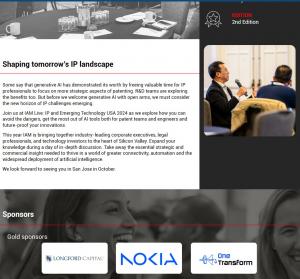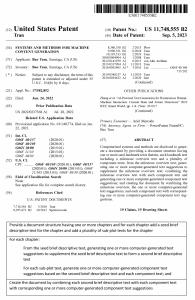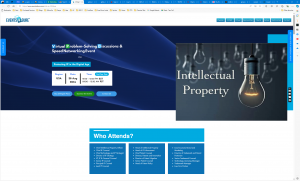PowerPatent Announces Solution to convert Scientific Publications into Non-Provisional Patent Applications
PowerPatent Announces Solution to convert Research Publications into Non-Provisional Patent Applications at AUTM Annual Meeting in DC.
WASHINGTON, DC, UNITED STATES, October 28, 2024 /EINPresswire.com/ -- PowerPatent announces a new solution to convert PDFs submitted for scientific and engineering research publication into full blown patent applications. The solution serves the needs of university technology transfer offices (TTOs).
Converting scientific publications into patent applications is an essential, albeit complex process for TTOs that want to maximize the commercial impact of academic research. By understanding the distinct requirements of patents compared to publications, selecting research with patent potential, and working closely with researchers, TTOs can translate groundbreaking discoveries into valuable intellectual property.
However, filing scientific/research publications as patent applications had been challenging and expensive. This process requires balancing the dense, technical language of academic papers with the specific requirements of patent applications. For TTOs, it’s not just about protecting research—it’s about enhancing the university’s value by translating complex science into a practical asset.
PowerPatent's new solution makes the patenting process manageable, even for those who aren’t patent experts. While scientific papers are thorough, patent applications require specific details about how the invention works, functions, and solves a problem. PowerPatent's new solution addresses these issues in a cost-effective manner. Here’s how it works:
1. Seamless Upload and Analysis
The process begins with the simple upload of a scientific paper in PDF format. PowerPatent’s AI analyzes the document, extracting key elements such as figures, tables, and text, as shown in the screenshots. This automated analysis saves time and reduces the risk of human error, ensuring that all relevant information is captured accurately.
2. Automated Claim Generation
One of the most critical components of a patent application is the claims section, which defines the scope of legal protection. PowerPatent’s AI generates a preliminary set of claims based on the content of the uploaded paper. These claims are designed to capture the invention’s novelty and inventive step, providing a solid foundation for further refinement by TTO staff or external counsel.
3. Figure Extraction and Annotation
Figures play a crucial role in illustrating an invention’s features and functionality. PowerPatent extracts all figures from the PDF and allows users to annotate each figure with a parts list. This feature ensures that every aspect of the invention is clearly documented and easily understood by patent examiners.
4. Structured Patent Application Drafting
Once the analysis and annotations are complete, PowerPatent organizes the content into a proper patent application format. This includes sections such as background, summary, detailed description, claims, and drawings. The software ensures that all elements are logically structured and compliant with patent office guidelines.
5. Inventor Review and Collaboration
After generating the draft, PowerPatent facilitates collaboration between inventors, TTO staff, and external counsel through its cloud-based platform. Users can review and edit the draft in real-time, ensuring that all stakeholders have input into the final application before filing.
Converting scientific publications into patent applications is an essential, albeit complex, process for university technology transfer offices (TTOs) that want to maximize the commercial impact of academic research.
By understanding the distinct requirements of patents compared to publications, selecting research with patent potential, and working closely with researchers, TTOs can translate groundbreaking discoveries into valuable intellectual property.
Incorporating strategic steps, such as thorough prior art searches, well-crafted claims, and leveraging AI tools, streamlines this process. Drafting a patent that balances technical detail with legally sound claims can turn scientific ideas into protected innovations with commercial applications. International filings expand the invention’s reach, allowing universities to tap into global markets while enhancing their reputations for innovation.
As the bridge between academia and industry, TTOs have a unique role in protecting and promoting research. This guide equips TTOs with the knowledge to navigate the patenting process effectively, making it easier to support researchers, protect innovations, and ultimately bring more university-developed technology into the world.
Why Convert Publications to Patent Applications?
1. Protecting Novelty and Inventiveness under First-To-File Deadline
Filing a patent application before publishing ensures that the invention's novelty is preserved. This is crucial because any prior public disclosure can be used as prior art against a patent application, potentially invalidating it. By filing a provisional or non-provisional application first, TTOs can secure an early filing date, which acts as a safeguard against subsequent disclosures. With the attention paid by TTO personnel on the claims at the time of provisional filing, the case is focused for Section 112 support and description requirements.
2. Strategic Use of Non-Provisional Patent Applications as filed Provisional Applications
Provisional applications offer a cost-effective way to establish an early priority date without the need for formal patent claims or detailed descriptions required in non-provisional applications. They provide a 12-month period during which researchers can refine their inventions and assess commercial viability before committing to the higher costs of a non-provisional application. PowerPatent provides a non-provisional application that can be filed as a provisional to provide life extension and a year to refine the invention before conversion as a non-provisional application. Since the provisional application is already formatted as a patent application due to PowerPatent's transformation, the resulting provisional application can easily and inexpensively be converted to a non-provisional by in-house or outside counsel, extending the TTO budget.
3. Cost Management
Transitioning publications into provisional applications can significantly reduce upfront costs associated with IP protection. This approach allows TTOs to defer substantial costs until there is greater certainty about an invention's commercial potential.
4. Enhancing Commercialization Potential
Patents are valuable assets in technology transfer, enhancing the attractiveness of university innovations to potential licensees and investors. By securing patent protection early with non-provisional patent protection filed as a provisional application, TTOs can better position their technologies for licensing deals or startup formation, ultimately increasing the likelihood of successful commercialization.
5. Collaborating with Researchers to Clarify Invention Details
Effective collaboration with researchers is essential for translating dense academic research into a patent-ready format. Researchers often have deep technical knowledge but may not fully understand patent requirements. TTOs can involve researchers as early as possible in the patenting process using PowerPatent's collaboration feature that supports tight communication between the TTO team, the inventors, and outside counsel. For TTOs, working with patent attorneys or agents can help refine the assessment process. These professionals understand patent law intricacies and can offer insights into the invention’s patentability. Teams can discuss the goals, key points of the invention, and how it aligns with potential patent claims. Regular communication can keep researchers engaged and invested in the patent process.
Mary Kimani
PowerPatent
+ +1 800-234-3032
email us here
Visit us on social media:
Facebook
X
LinkedIn
YouTube
Other
Use Technology to Cut IP costs
Legal Disclaimer:
EIN Presswire provides this news content "as is" without warranty of any kind. We do not accept any responsibility or liability for the accuracy, content, images, videos, licenses, completeness, legality, or reliability of the information contained in this article. If you have any complaints or copyright issues related to this article, kindly contact the author above.





